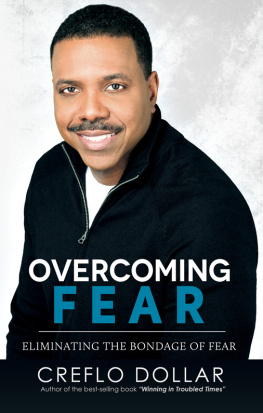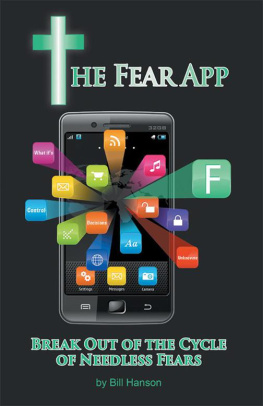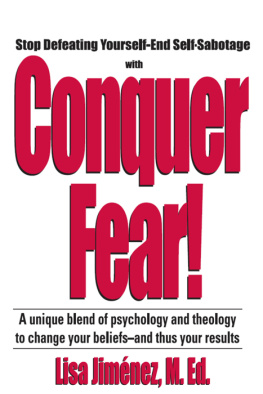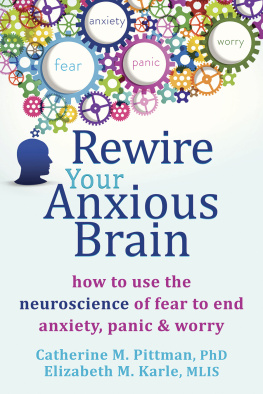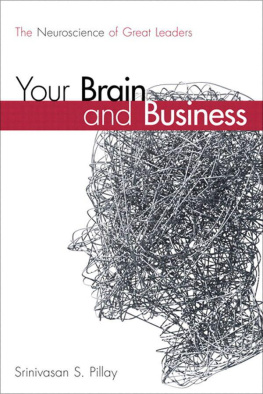


To my parents, Raz and Sava, and brother, Rajan, whose astonishing and unflinching love and dedication have inspired in me the need to reach out to the world with the gesture that this book represents.
[contents]
1 What you dont know can hurt you
Moving Beyond Unconscious Fear
2 The science of overcoming dread
How Human Brain Biology Can Support an Attentive, Inspired, and Positive Life
3 Fear of success
The Biology of Understanding and Transcending the Largest Fear Paradox
4 If its hard to change, its not unchangeable
Overcoming Fear Conditioning in the Human Brain
5 Unlocking a caged heart
Melting Ironclad Fear into Secure Attachment
6 Fear and prejudice
The Biology of Bigotry
7 How to develop emotional superglue
Fear, Trauma, and Piecing Together the Human Psyche
[acknowledgments]
I would like to acknowledge the work of all the great scientists who have made this book possible. Without their curious and contentious ways, we would be much poorer for solutions to overcome the fears that trap us in the cages of our everyday lives.
I would also like to acknowledge Jonathan O. Cole, MD; Leston Havens, MD; Shervert Frazier, MD; and all of my mentors through the yearsincluding Deborah Yurgelun-Todd, PhD; Bruce Cohen, MD, PhD; and Scott Rauch, MDwho have been guiding lights that have helped me understand my place and movement in the world.
Last but not least, to all those who love me and to those who afford me the gift of loving themI thank you with all my heart and pass on the love through this book to those whose lives may be touched by the place where the human spirit finds its metaphor and meaning in science.
[1]
What You Dont Know Can Hurt You
Moving Beyond Unconscious Fear
Death is not the biggest fear we have; our biggest fear is taking the risk to be alivethe risk to be alive and express what we really are.
Don Miguel Ruiz
The human condition is a vulnerable but powerful one, based on the primitive brain forces of animals lower in the evolutionary chain yet surrounded by a shell of magnificent brain tissue that gives us our unique abilities to think, speak, and express ourselves as we do. These primitive forces of the unconscious brain crouch on all fours as they scour our surroundings for signs of imminent danger. The unconscious brain is never truly silent, always purring in the background, bathing its thinking counterpart with vigilant warningsWatch out! Dont go there! Be careful! Kindled by a constant flow of electrons, which slide down one neuron and into another in milliseconds, the unconscious brain lights up at the mere hint of danger.
The conscious brain picks up this heat and relies on it in the way that we rely on the sun for our survival. Yet this giving of the unconscious is a double-edged sword, as is much of human nature. This same heat that protects us can also burn us when it is not regulated. And cooling down the dubious gift of fear is no easy feat. This tension between the conscious and the unconscious brain, the latter with its suffocating diligence and overprotectiveness, is in many ways responsible for much of our daily ambivalence.
No wonder, then, that recent research has shown that we are consistently unable to recognize the things that will make us happy. Given a few choices, we almost always make the choice that leads us into trouble. So, many of us blame ourselves for not making the right choices in our lives without realizing that in many situations, our choices are beyond our immediate control. They are locked up in the invisible cage of fear that is the unconscious. To unlock this cage, we have to first see it. But seeing fear requires much more than just recognizing our inner tremblings. It requires a special kind of attention and knowledge that a vast body of scientific research permits us to employ. In this chapter, we will explore some of this knowledge, with the goal of gaining a deeper understanding of the inner workings of fearso that we can do something about it.
Every day, people tell me the stories of their lives: people who want to move in one direction, but instead find themselves moving in another; people who claim to be trying, but repeatedly find themselves failing; people who are bored and stuck, yet are unable to make the changes they know they want to make; and parents who worry that their children are depressed, have learning disabilities, or suffer from attentional problems that just arent improving despite intervention and treatment. If we know what we want, why are we unable to act on it? Why are we unable to follow the directions given by our conscious minds and reach our goals unimpeded? And when we do try to do the right things, why are we unsuccessful? For many, this is a source of much heartache. Whether it is a tortured relationship or a difficult job situation, we often feel regretful after we realize weve made the wrong choice. Why do we continue to make these choices, and what steers us toward them in the first place?
If we are consciously doing our best and yet not getting to where we want to go, something outside of our consciousness must be driving us in another direction without our knowledge or consent. I call this the rip current of human nature. A rip current is a very powerful surface flow of water that is returning to the sea from close to the shore. It can turn an eerily calm-looking body of water into something extremely dangerous that has the power to drag swimmers out to sea. Many people caught in rip currents eventually drown due to the sheer exhaustion of trying to swim against the current.
The unconscious is the rip current of the mind. From a distance, its calm, barely noticeable, and difficult to anticipate. And at its core lies the threatening force of fear. Much like a rip current is helpful to surfers who rely on its force to pull them away from shore, fear may be helpful if it urges you forward toward your goal. But like the unpredictable rip current, fear can also drag you away from your goals and destinations.
When Sigmund Freud, the father of psychoanalysis, listened to his patients relate their lives as they lay on his couch, he concluded that their behavior was motivated by factors outside of their immediate awareness. Though mysterious and somewhat unsettling, this idea was appealing enough that it formed the basis of psychoanalytic therapy for many decades. The fundamental idea was this: We are capable of doing things that may be the exact opposite of what we actually want for ourselves because our unconscious motivations conflict with our conscious intentions. When Freud told the world that human suffering could be alleviated by understanding the unconscious, many people supported this theory. Yet, for those who required hard evidencefor those who could not heal themselves with abstractionsthere remained a void and a strong suspicion that Freuds conjecture was unfounded and had no basis in reality.
In this chapter, we will come to understand the many ways in which Freud was correct about our unconscious motivations, as well as the other important insights into human behavior that have since been brought forth. We will also come to understand how this powerful, unconscious fear keeps us from living our fullest livesand what we can do to transcend it.
Next page


